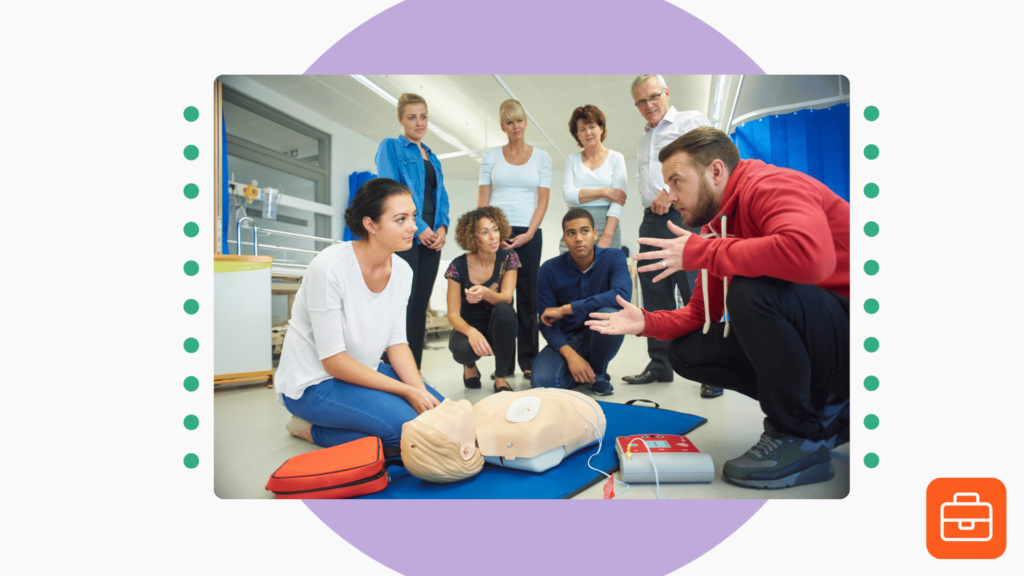Working in EHS can make it hard to set aside time for professional reflection and development. But luckily there are always opportunities to develop your skills, knowledge, team, and facility. Here are some goals for safety professionals that cover all these areas (and more).
Professional development
When it comes to professional development in safety, there are lots of different goals you can set. You want to make sure that these goals align with the type of roles you want to have in the future, rather than the role you have right now.
Here are few EHS professional development goals you might consider setting for yourself:
- Attend at least one EHS event (expo, clinic, workshop, seminar, etc.) per year.
- Find a mentor and commit to connecting with them at least once per month.
- Pick at least one EHS or industry publication to follow and set aside time each week to get updated on the latest news in your field.
- Get a new certification in the next 6-12 months.
- Join a local safety council, professional group, etc., to network with peers.
When you’re setting these goals, think about where you want your career to go. Do you want to stay in frontline EHS management? Do you aspire to be a senior leader? If your dream is to move up into higher-level roles, incorporate some leadership knowledge into your professional activities.
EHS professional certifications
One of the most common goals for safety professionals is to get a certification. Here are some options you can consider looking into:
- CSP or ASP
- CIH or CHMM
- OHST
[Check out our post on the 6 best EHS certifications for safety professionals for more information]
You can also explore areas outside of EHS like:
If you think you might want to move to other areas of the business at some point, these are great options to consider. Getting a certification requires time and money, so make sure you think carefully before pursuing it. You’ll need to have the bandwidth to study and prepare while also doing your full-time job.
Safety leadership
Being a safety leader isn’t just about managing direct reports. It’s about setting an example for everyone within the site or company to follow. When you’re setting goals for yourself, think about how your behavior might influence frontline workers, direct reports, and senior leadership.
Here are a few ideas of goals that cater to each of those three groups:
Frontline workers:
- Form a safety committee and include workers from different departments.
- Conduct a safety culture survey each quarter and let workers share feedback.
- Upgrade at least one category of communal PPE each year (coats, harnesses, etc.).
Direct reports:
- Conduct a monthly one on one meeting with each of your direct reports.
- Help each person on your team develop a specific professional skill.
- Give each person on your team the opportunity to lead a project or initiative.
Senior leadership:
- Complete one cost-savings initiative bi-annually and report on the results.
- Schedule a monthly safety walkthrough with upper management to explain and show them the most pressing issues within the facility.
EHS management
Of course, this list wouldn’t be complete without some examples of goals for safety professionals to set in their departments. Consider creating a goal to:
- Increase the number of near misses reported.
- Decrease TRIR.
- Reduce the number of failed audits and/or inspections.
- Improve new hire safety training test scores.
- Decrease total time of onboarding process.
- Reduce the number of overdue training items.
- Reduce the percentage of action items past due.
When it comes to setting these types of goals, let the data guide you. Where is your site struggling to maintain compliance? Which areas of performance are below company or site standards?
Internal process improvement
Aside from EHS KPIs, take a look at your internal processes. Where do you expend the largest portion of your resources? What could your team be doing more or less of? How satisfied are you with the quality of your EHS processes like documentation, reporting, investigation, training, and procurement?
- Overhaul and improve the EHS documentation process.
- Reduce the number of incomplete reports.
- Create a standard system for naming, storing, and organizing EHS documents.
- Get health and safety ISO certifications like ISO 45001 and ISO/PAS 45005.
- Do a PPE supplier evaluation and determine if there are better options to explore.
Don’t make the mistake of believing that goals for safety professionals are limited to EHS performance specifically. Make them as much about the people as the process. That can involve how your team gets work done, how well your team works together, and the long-term trajectory of your site’s safety program.




